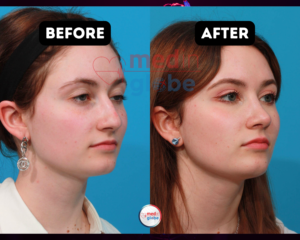Rhinoplasty
Rhinoplasty, known as nose surgery in medical literature, refers to surgical interventions aimed at correcting or improving the shape, size, or function of the nose. Nose surgery can be performed for patients with both aesthetic concerns and those with nasal conditions affecting their functions.
Nose Surgery: The Key to Reshaping Yourself
Beauty is an important concept that boosts people’s self-confidence and enhances their quality of life. Everyone has a different perception of beauty, and a part of this perception relates to our faces. The central and most striking feature of our faces is the nose. The nose is crucial in influencing facial symmetry and balance. However, sometimes people are not satisfied with their noses and may experience a lack of self-confidence due to shape, size, or functional issues. This is where nose surgery, or medically known as “rhinoplasty,” comes into play.
What Is Rhinoplasty?
Rhinoplasty is the medical term for nose surgery, a surgical procedure performed to correct the appearance, shape, or function of the nose. Rhinoplasty can be done for both aesthetic reasons and to correct nasal problems. This procedure can help individuals feel better about themselves and boost their self-confidence.
Purposes of Rhinoplasty
This surgeries can be performed for different purposes:
Aesthetic Purposes:
Correcting the shape and size of the nose.
Addressing bumps or depressions on the nasal bridge.
Reshaping the nasal tip.
Improving nose and facial proportions.
Functional Purposes:
Correcting the nasal septum (the inner nasal partition).
Resolving breathing problems.
Rectifying nasal congestion.
How Is Rhinoplasty Performed?
This surgery typically involves the following steps:
Anesthesia: Nose surgeries are usually performed under general anesthesia, although local anesthesia and sedation can also be used.
Surgery and Incisions: During nose surgery, the surgeon makes incisions either inside or outside the nose. The incisions are usually located under the eyes or inside the nose and often become virtually invisible over time.
Postoperative Recovery: The recovery process for nose surgery can vary from person to person, but swelling and bruising are commonly observed in the first few days. You may need to wear a special nose bandage and splint. Heavy physical activities should be restricted during the recovery period.
Results: Nose surgery results in the correction or improvement of the nose shape and appearance. The outcomes can vary depending on the patient’s personal goals and the skill of the surgeon.
Nose surgery should be performed by a specialist plastic surgeon, and the risks and outcomes of the surgery should be discussed in detail with the patient. It is important to follow pre-operative and post-operative care instructions.
Aesthetic Rhinoplasty:
Purpose: Aesthetic nose surgery is performed to improve the shape and appearance of the nose. These procedures aim to correct aesthetic features of the nose that patients find bothersome, such as shape, size, symmetry, or nasal tip.
Procedure: The surgeon makes incisions inside or outside the nose and reshapes the nasal cartilage and bones. The incisions are usually located under the eyes or inside the nose and often become virtually invisible over time.
Anesthesia: Generally performed under general anesthesia.
Recovery: The recovery process varies from patient to patient, but swelling and bruising may last for several days.
Functional Rhinoplasty (Septoplasty):
Purpose: Functional rhinoplasty aims to correct nasal obstructions and breathing problems. These surgeries may involve correcting the nasal septum, the inner partition of the nose.
Procedure: The surgeon makes incisions inside the nose and may correct the nasal septum or open narrowed areas inside the nose.
Anesthesia: Generally performed under general or local anesthesia.
Recovery: The recovery process is often shorter than aesthetic nose surgery, and patients typically experience a faster recovery.
Revision Rhinoplasty:
Purpose: Revision rhinoplasty is a repeat surgery for patients who are dissatisfied with or experience complications from a previous rhinoplasty. It is suitable for patients unhappy with the results of a nose surgery or facing new issues.
Procedure: Revision rhinoplasty is performed to correct previous surgery results or address new problems. These surgeries can be more complex as tissues may have changed due to previous surgery results.
Anesthesia: Generally performed under general anesthesia.
Recovery: The recovery process for revision rhinoplasty can vary depending on the complexity of the previous surgery and the patient’s condition.
Each type of nose surgery should be planned according to the individual needs and goals of the patient and should be performed by an expert plastic surgeon. It is essential to follow the doctor’s recommendations before and after surgery.
The recovery process after nose surgery can vary from person to person but typically lasts for a few weeks. Swelling and bruising may be present in the initial days. However, as your results improve, your nose will achieve a more balanced and pleasing appearance.
Reshape yourself with rhinoplasty, feel more confident, and enhance your quality of life. If you are considering such surgery, be sure to consult with our expert plastic surgeons. Your surgeon will understand your expectations and help you achieve the best results.
Rhinoplasty is a way to reshape your nose and thus your face. This surgery is preferred for both aesthetic and functional reasons and can boost your self-confidence. Contact us to learn more and find out if the surgery is right for you. A new nose may await a new you.
Rhinoplasty Before After Gallery
Contact Us Directly
You can always contact us via our Medinglobe Whatsapp Support Line.
Make an Appointment

